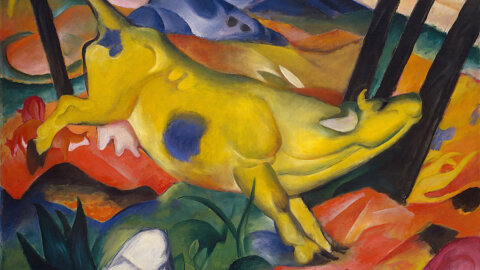Vamba: nasce la letteratura per ragazzi con un modello cattivo e malestroso “Gian Burrasca”.
Viva la pappa con pomodoro
di Michele Giocondi e Mario Mancini
Ed eccoci giunti al 28° episodio della serie degli autori best seller italiani. Scende in campo la letteratura per ragazzi che, come sappiamo, è sempre stato il settore più dinamico dell’industria del libro in tutto il mondo. Ma in Italia con Vamba succede qualcosa di nuovo: arriva il ragazzo discolo, indisciplinato e insolente. Non certo un modello per le famiglie e i ragazzi dell’epoca. Ma il successo del personaggio è tale da lasciare sbalorditi anche come fenomeno culturale e sociologico.
Il libro per ragazzi
Se c’è un periodo in cui la produzione di libri per ragazzi ha attraversato una fase di particolare fervore, questo è stato proprio quello a cavallo del Novecento: qualche anno prima, qualche anno dopo. In questi anni si è concentrato quanto di meglio si sia scritto, a cominciare da De Amicis, per proseguire con Collodi e Salgari, per concludere infine con Vamba. E senza dimenticare, ovviamente, i tanti altri scrittori, che si sono cimentati nel genere in questo periodo.
Dalla loro penna sono nati i personaggi che hanno plasmato l’immaginario giovanile, e non solo il loro, grazie alla creazione di figure che sono diventate immortali sia per la nostra società che per il mondo intero, primo fra tutti Pinocchio.
Sono stati libri composti sotto stimoli diversi: per il pungolo dei soldi che mancavano sempre per le spese domestiche, come capitava a Salgari, alle prese con una famiglia onerosa e una moglie gravemente malata da un punto di vista psichico. O composti in fretta e furia per rimediare a qualche perdita di gioco, in piedi, appoggiato a un piccolo ripiano, in un angolo della libreria-casa editrice cui collaborava, come capitò a Collodi. E senza alcuna fiducia su quello che usciva dalla sua penna, anzi convinto di lavorare a una “bambinata”, solo per racimolare quelle mille lire concordate col suo editore, assolutamente ignaro del capolavoro che stava per spiccare il volo verso l’eternità.
Ancora diversa la elaborazione di Cuore, meditato a lungo, preso e ripreso in mano più volte, e mai portato a compimento; infine concluso rapidamente in una stagione particolarmente ispirata, come capita talvolta agli scrittori.
Il Giornalino di Gian Burrasca ha avuto invece una gestazione ancora diversa. Intanto è successivo a loro di una ventina di anni ed è stato composto durante la normale e operosa attività di un giornalista e caricaturista, appassionatamente immerso nella lotta politica del periodo, ma nel momento in cui cominciava in qualche modo a prenderne le distanze, deluso dall’irrilevanza dei risultati del suo impegno politico.
Ma l’impatto che ha determinato nei nostri ragazzi e nell’intera società per più generazioni non è stato molto inferiore a quello dei grandi capolavori che l’hanno preceduto.
Nacque dalla penna matura e solida di un giornalista, direttore e fondatore di giornali che alla sua professione univa anche la passione per la divulgazione giovanile e la formazione dei ragazzi: Luigi Bertelli.
La vita
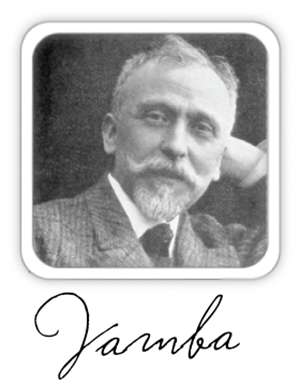
Luigi Bertelli nasce a Firenze nel 1860, ma alcuni anticipano la data di un paio d’anni, in una famiglia della piccola borghesia, padre impiegato e possidente. Le condizioni familiari permettono ai genitori di farlo studiare presso gli scolopi, e lì conclude gli studi nonostante la morte prematura del padre quando lui ha 13 anni. Preso il diploma il giovane si cerca un lavoro e lo trova alle ferrovie, con destinazione finale a Foggia.
Nello stesso tempo inizia a dare sfogo alla sua grande passione, quella per il giornalismo, collaborando al settimanale romano “Fanfulla della domenica” e al quotidiano “Capitan Fracassa”. I suoi pezzi sono molto incisivi, colpiscono i lettori, tanto che il direttore del “Capitan Fracassa” Luigi Arnaldo Vassallo, noto col soprannome di Gandolin, gli offre un posto fisso di redattore. Bertelli lo accetta per niente dispiaciuto di rinunciare al lavoro sicuro alle ferrovie, in realtà mai amato, e a 26 anni inizia l’attività giornalistica.
Questa non avrebbe mai avuto una continuità in una sola testata per più di qualche anno, e lo avrebbe portato a lavorare per più giornali, spesso nati e morti nello spazio di un mattino, ma sempre coerentemente e irriducibilmente sul versante politico mazziniano, laico, repubblicano, nazionale e progressista.
Lo pseudonimo Vamba
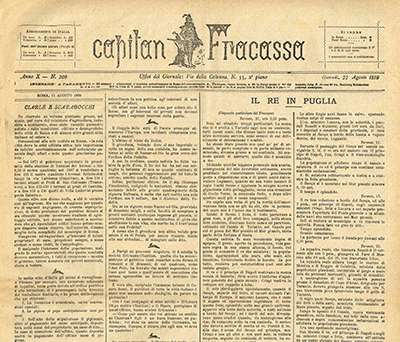
È in questo periodo che adotta lo pseudonimo che manterrà sino alla fine: Vamba, il nome del buffone di Ivanhoe, ma anche, teneva a precisare lui stesso, quello di un sovrano visigoto, quasi a sottolineare la sua doppia natura, sì di umorista, ma anche di combattente impegnato nella battaglia ideologica.
La salita al potere di Crispi nel 1887 spinge il “Capitan Fracassa”, sino ad allora ostile al governo e al suo presidente Depretis, su una posizione filo-governativa. E allora Vamba, il direttore Gandolin e altre firme, abbandonano il giornale e ne fondano un altro, “Don Chisciotte della Mancia”, da dove riprendono la loro lotta al governo. La neonata testata sopravviverà fra alti e bassi per soli cinque anni, fino al 1892. Poi proseguirà dal 1893 fino al 1899, guidata sempre dallo stesso gruppo, col parzialmente nuovo titolo di “Don Chisciotte di Roma”.
Sono anni di duro lavoro e di notevole impegno nella lotta politica, condotta sempre con fiera e talvolta feroce causticità contro le manchevolezze, le ipocrisie, le malefatte della parte avversa, irrisa e denigrata con pezzi e caricature, pur contestabili ideologicamente, ma di grande efficacia giornalistica. Memorabili gli attacchi ai potenti del periodo, dal Crispi al papa Leone XIII, che pur su versanti opposti, venivano accomunati nella critica e nella derisione di Vamba.
La difficile situazione della stampa
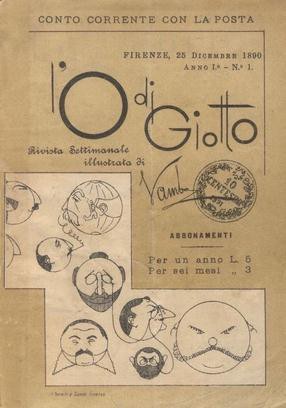
Lo scarso numero di lettori, in un paese dove rimane ancora molto alto il tasso di analfabetismo, stimato in quegli anni alla metà della popolazione, la nutrita presenza di testate, mai così alte in Italia come in quel periodo, con diffusione di poche o pochissime migliaia di copie giornaliere, e talvolta anche meno, rende sempre stentata la vita dei vari giornali. E precaria l’esistenza di chi ci lavora.
Nel 1890, dopo varie esperienze e collaborazioni in testate effimere, Vamba rientra a Firenze e fonda l’“O di Giotto”, un altro giornale, “chiaro e tondo” come preciserà lui, quasi fosse questo un impegno e un marchio della sua professione, e sempre della stessa sponda politica repubblicana e mazziniana.
E da qui riprende ancora una volta la lotta agli intrighi, alla corruzione, al malcostume che secondo lui perdura e non si riesce ad estirpare dal paese.
Non disdegna neanche di collaborare, anche per necessità pratiche, dato che nel frattempo ha messo su famiglia, come disegnatore ad altri periodici. La rivista però avrà vita breve, due soli anni.
La svolta verso il mondo dei ragazzi
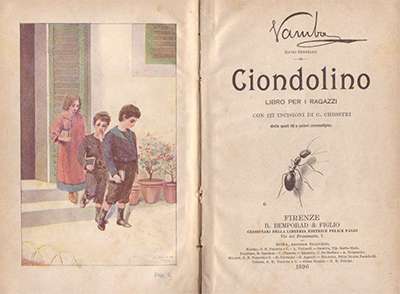
Una svolta nel frattempo comincia lentamente a maturare. Vamba inizia a sentirsi deluso e amareggiato sulle sorti di un paese che rimane sempre uguale e immodificabile nei suoi tratti di fondo, nonostante le alchimie politiche, i cambi di governo, le varie personalità che si affacciano sull’arengo politico, i propositi di mutamento mai giunti ad effetto (un qualcosa cui avremmo assistito, mutatis mutandis, in altre epoche della nostra storia, anche recentissima).
E allora decide di allargare il suo raggio d’azione dalla lotta politica all’impegno nel mondo dei ragazzi. Lo fa nel nome della chiarezza, dell’onestà, della necessità di non mentire loro, di educarli e di prepararli alla maturità, nella speranza che siano poi loro a prendere in mano il paese e a realizzare quegli ideali che la sua generazione non è in grado di portare a compimento.
Non è, a dire il vero, una svolta brusca, né verso un mondo del tutto sconosciuto a lui. Un primo approccio in questo settore si era avuto nel 1895, con la pubblicazione di Ciondolino, un romanzo per ragazzi che era una via di mezzo fra la divulgazione scientifica e l’intento moralistico-pedagogico. Ma adesso il suo impegno in questo settore si fa sempre più intenso. Sarà questo il solco che approfondirà progressivamente e che lo porterà, come si può facilmente intuire, sulla strada del suo capolavoro: Gian Burrasca.
Fonda il “Giornalino della domenica”
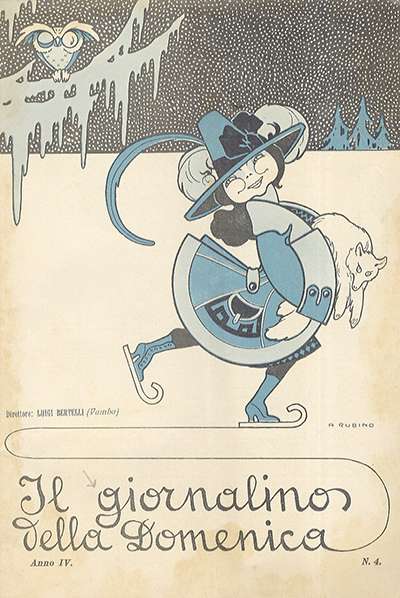
Notevole anche l’apporto di grafici e illustratori che impreziosiscono il periodico e che ovviamente non può costare poco: 25 centesimi a numero, quando un quotidiano costava allora 5 centesimi e a volte anche meno, anche 2 centesimi, giusto il resto di un sigaro che ne costava 8. E un quotidiano bolognese era nato proprio su questa intuizione!
Nasce Gian Burrasca
È su questo settimanale che fra il 1907 e il 1908 escono a puntate le avventure di Gian Burrasca.
La tiratura del settimanale però non decolla, nonostante si sia in quegli anni in un periodo pur di miseria, ma sicuramente migliore del passato o quanto meno come non si era mai visto in precedenza. Sono gli anni giolittiani in cui qualche spesicciola in più, ma non più di tanto, si poteva insomma fare, e come riconosceva anche Renato Serra in un suo celebre intervento il mercato librario cresceva e i libri, in qualche modo, si vendevano.
Ma i lettori del “Giornalino” rimangono sempre pochi. La botta determinante avviene dal 1908 in poi quando nasce il “Corriere dei piccoli”, con caratteristiche analoghe, ma non identiche, e ad un prezzo che è comunque meno della metà: 10 centesimi. Dopo tre anni di difficile e stentata sopravvivenza il “giornalino” di Vamba è costretto a chiudere, come i molti altri in precedenza.
Prosegue l’impegno sul versante dei ragazzi
Il nostro attivissimo autore non depone però la penna, anzi continua imperterrito il suo lavoro, sempre sul settore giovanile dando alle stampe libri di divulgazione storica e scientifica, di storia romanzata e testi per le scuole elementari. Continua a cercare di forgiare i giovani per farne dei cittadini consapevoli e responsabili.
L’entusiasmo per l’impresa di Fiume di D’Annunzio
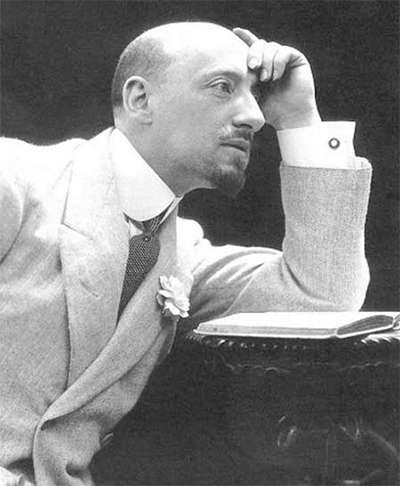
Un singulto di entusiasmo si insinuerà nel suo cuore in conseguenza dell’impresa di Fiume di D’Annunzio, allorché gli pare che per un qualche sortilegio siano riemersi quei valori nei quali aveva creduto profondamente e per i quali si era speso una vita intera, compreso quello per le giuste esigenze nazionali, da non confondere però con quelle imperialistiche, dell’Italia.
Ci rimangono in tal senso articoli e testimonianze su quel “fulgido” periodo proprio sulle pagine del suo “Giornalino”, che dal dicembre del 1918 ha ripreso a uscire a Roma. Sono pezzi di grande entusiasmo per l’impresa di D’Annunzio, che lo inviterà di persona a recarsi a Fiume e lui vi andrà trattenendovisi due mesi a fine 1919.
Destino vuole che Vamba muoia proprio a fine novembre 1920, quando si sta concludendo l’esperienza del suo rinato “Giornalino” (ripartirà poi nel 1921 con altro editore) e in cui col “Natale di sangue” termina l’impresa dannunziana di Fiume.
Il Giornalino di Gian Burrasca era nel frattempo uscito in volume nel 1912 con l’editore Bemporad di Firenze, e da fine anni Settanta sarebbe stato stampato da altri grandi editori, Mondadori e Rizzoli per primi. Il libro ha raggiunto tirature altissime, per un totale difficilmente calcolabile, ma nell’ordine di qualche milione di copie.
Anche il cinema e la TV si appropriano del romanzo
Memorabile rimane però la riduzione televisiva in otto puntate che ne fece Lina Wertmuller a metà anni Sessanta, che ha tenuto incollato al piccolo schermo tutto il paese, con Rita Pavone nelle vesti del protagonista e le musiche di Nino Rota.
Gian Burrasca un termine entrato nell’uso comune
Con le vicissitudini di Giannino Stoppani, incapace di accettare le norme di comportamento dei grandi e di capirne la loro ipocrisia, Vamba ha rappresentato l’archetipo del ragazzo discolo e un po’ birbante, ed è entrato a pieno titolo anche nella nostra lingua, tanto che giamburrasca è diventato un termine di uso comune, presente in tutti i dizionari dei sinonimi per indicare il ragazzo birbante, discolo e malestroso. Un termine insomma che proprio grazie a lui è diventato patrimonio della nostra lingua.
Immagine: La copertina del “Corriere dei Piccoli” dedicata a Rita Pavone interprete di Gian Burrasca nella fortunata serie miniserie televisiva diretta da Lina Wertmüller, andata in onda sulla RAI TV nel 1964–65. Musiche di Nino Rota.




